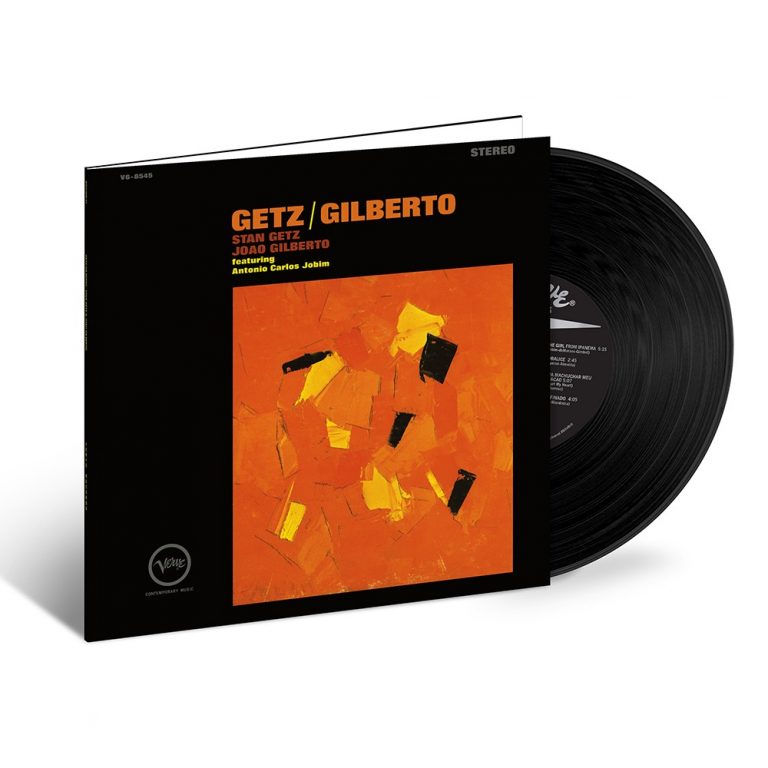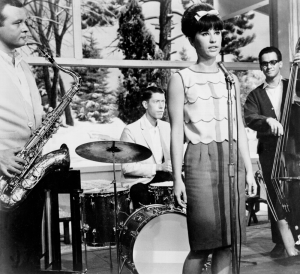A decade before George Benson’s “Breezin’” and Weather Report’s “Birdland”, a different kind of fusion music was exceeding all commercial expectations and winning Grammy awards. But the more one looks into “The Girl From Ipanema” and its attendant “Getz/Gilberto” album – released in early March 1964 and named for tenor saxophonist Stan Getz and husband/wife team João and Astrud Gilberto – the more their success seems inevitable.
Firstly, there was the simpatico relationship between Getz and the album’s chief writer and pianist, Antonio Carlos Jobim. They were almost identical in age, born just eight days apart, and Getz represented to Jobim the quintessential West Coast cool-jazzer, a key link to bossa nova influences like Lester Young, Gerry Mulligan and Chet Baker.
Then there’s the curious aspect that beaches feature strongly in both bossa nova and West Coast jazz; the former had Rio’s Ipanema Beach as a cornerstone (Jobim lived just a few minutes’ walk away), the latter’s centre of operations was a venue called The Lighthouse on Hermosa Beach near Los Angeles.
Another key factor was the steady hand of Verve house producer Creed Taylor, who had already shepherded Getz to two hit albums in 1962 with “Jazz Samba” and “Big Band Bossa Nova”. Taylor, alongside engineer Phil Ramone, ensured that the bossa and jazz elements fused perfectly on “Getz/Gilberto”, with neither style being watered down.
Despite the sheer loveliness of Getz’s tenor tone throughout, his muscular playing enlightens “Ipanema”, “Só Danço Samba” and “Corcovado” in particular, reminding one of the time when he toured and recorded with a tough rhythm section featuring drummer Roy Haynes.

STAN GETZ & JOÃO GILBERTO Getz / Gilberto
Available to purchase from our US store.Taylor was absolutely convinced that the album, recorded at CBS’s 30th Street studio in New York City on 18 and 19 March 1963, would become a huge hit, particularly with Jobim’s contribution, but he later revealed to Michael Jarrett for the book “Pressed For All Time” that the Gilbertos were extremely nervous about appearing: “They were kind of holed up and wouldn’t come out of the hotel. [Wife of Stan] Monica Getz went over and got them to the studio.”
Though Brazilian poet and playwright Vinicius de Moraes had written the Portuguese words to “Ipanema”, Norman Gimbel wrote the English lyric, coming up with the controversial opening “Tall and tan…” (the Portuguese version features five syllables in its first line).
Astrud reportedly inserted the line “She looks straight ahead, not at he” on the spot (many female singers, including Ella Fitzgerald, have covered the song as “The Boy From Ipanema”). Despite this, according to Gene Lees’ book “The Singers And The Song II”, Astrud wasn’t paid a penny for the “Ipanema” session and Getz also later campaigned strongly – and successfully – to make sure she didn’t get any performance royalties.

“Getz/Gilberto” was a huge commercial and critical hit, winning Album Of The Year at the 1965 Grammy Awards, the first time a jazz player had been attached to that accolade, while “The Girl From Ipanema” won Record Of The Year. 60 years on, it’s hard to think of another song which better encapsulates shimmering, summery musical bliss.
Taylor knew a good thing when he heard it, and Jobim’s album “The Composer Plays”, recorded in May 1963, produced another sizeable bossa nova hit for Verve. Taylor then brought Jobim over to his burgeoning CTI label later in the 1960s.
For Getz’s part, he would briefly flirt with Latin rhythms on subsequent albums “Sweet Rain” and “Captain Marvel”, both featuring Chick Corea, but barely touched them between 1972 and his death in 1991. Maybe he knew he would never be able to top “Getz/Gilberto”.

STAN GETZ & JOÃO GILBERTO Getz / Gilberto
Available to purchase from our US store.Read on… A Sashay Through Astrud Gilberto’s Discography
Matt Phillips is a London-based writer and musician whose work has appeared in Jazzwise, Classic Pop, Record Collector and The Oldie. He’s the author of “John McLaughlin: From Miles & Mahavishnu To The 4th Dimension”.
Header image: Astrud Gilberto, credit: Metro-Goldwyn-Mayer/Getty Images.


